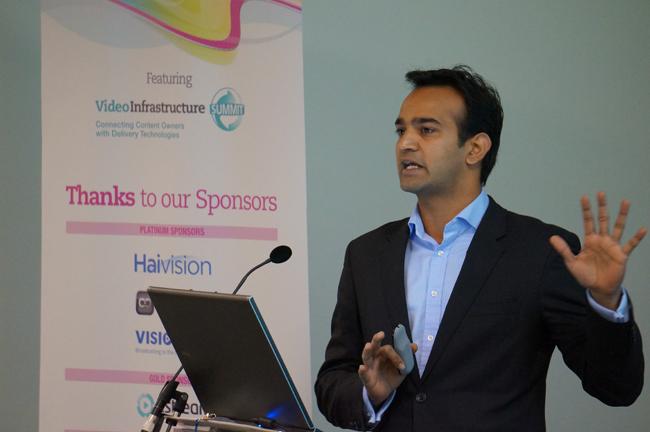Samsung: Video Apps Dominate for Smart TV Usage
Smart TVs can't just present web pages if they expect to succeed, said Samsung content service manage for Europe Sidharth Javant. Instead, they need to put video first and offer an experience that takes advantage of the larger viewing screen
Javant spoke this morning at the opening day keynote for Streaming Media Europe 2012, where he opened a window to Samsung's smart TV strategy. From the start, he said, Samsung saw that smart TVs shouldn't be complicated and should put the TV experience first. That's why the first smart TV apps delivered video content.
Viewers have responded by overwhelmingly using video apps on their TVs. Javant presented a chart showing that television catch-up programming apps get used 55.82 percent of the time and video-on-demand apps get used 30.38 percent of the time. That means over 85 percent of app use is purely video. Of the rest, sports apps get used 8.36 percent of the time, music gets 3.88 percent, and lifestyle gets 1.55 percent.
Samsung faced challenges in putting its smart TV platform forward, most notably creating a standard for partners to follow.
"Every time a new thing comes out and people get excited about it, there's always a standard about it. However, it's not always there when you're starting out," said Javant.
In creating a standard, Samsung listened to the digital rights management and quality demands from different parties, then created a common set of standards that it felt appealed to the widest number of partners. Samsung has added more standards over time, Javant said.

Samsung also needed to create a business model. While Javant didn't go into detail, he said that Samsung requires partners generating revenue on the Samsung smart TV platform to pay a share of that to Samsung.
While smart TV sales are increasing, some studies have asserted that few buyers actually connect them to a home network or use their online services. Javant couldn't give specific adoption rates, but said that the number started out low and is currently growing month on month.
"A lot more people use these devices nowadays," said Javant.
Looking to the future of smart TVs, Javant said that Samsung is working on shortening the home TV buying cycle. Currently, consumers buy a new set every six to seven years, on average. Samsung is working to shorten that to every four to five years. The company also sells companion devices, such as Blu-ray Disc players.
Javant looked at the full home entertainment value chain, including smartphones and notebooks, and the variety of partners that create and deliver content to those devices. With more devices comes more opportunity, noted Javant. For example, complementary content search drives more than 20 percent of tablet video viewing. Consumers own a variety of different devices for entertainment, using them together but in different ways. The future of smart TVs is working with that model and learning how to deliver tailored content and experiences for it.
Related Articles
The world of digital entertainment is rapidly changing, and video publishers need to learn from the lessons of the music companies.
07 Feb 2013
Cord-cutting is on the rise, the futures of Netflix and Google TV are up in the air, and services like HBO GO are paving the way for a true anytime, anywhere online video universe
28 Feb 2012
A Samsung exec thinks Steve Jobs cracked the problem of working with TV carriers and advertisers, but fell short of creating a device for the whole family.
30 Jan 2012